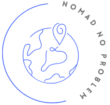Portal Cañadón Pinturas has jaw draping landscapes, wildlife sighting opportunities, and ancient cave paintings: all accessible on foot. While not usually on travelers’ radars, this part of Patagonia is one of Argentina’s natural and archaeological treasures.
Portal Cañadón Pinturas is one of the access points within the larger Parque Patagonia. Its location east of the Andes puts the arid steppe environment on full display: here you can see guanacos, choiques, pumas, dramatic canyons, and multi-colored rock formations.
If you’ve always dreamed of visiting Patagonia, you can’t skip hiking in Portal Cañadón Pinturas. Here you’ll find everything you need to know about how to get there, where to stay, and what the main attractions are.
Getting there
To get to Portal Cañadón Pinturas you’ll take Ruta Nacional 40 to the park entrance. Many people who visit the park stay in the nearby town of Perito Moreno or in Los Antiguos, a little farther west. But there are also lodging options within the park (more on this later).
| Need a rental car? Check out rates and availability here.
Once you arrive, you will need to stop at the visitor’s center to sign in. The park’s staff will give you a map, provide any information you may need on road conditions or the day’s weather, and you’ll be on your way. Entering the park is free.
The roads within the park are all gravel, but in pretty good condition. We drove around in a Fiat sedan without any concerns.

Best Hikes in Portal Cañadón Pinturas
There are over 60 kilometers (38 miles) of trails within the park, so there is a lot you can do! If I had to choose just a few, though, I’d say the main points of interest are the Tierra de Colores trail, Bajada de los Toldos trail, and the Alero Charcamata trail.
Tierra de Colores Trail
Distance: 3.4 km (2.1 miles)
Difficulty: rated moderate, but I think it’s closer to easy
The Tierra de Colores trail has one of Portal Cañadon Pinturas’ most iconic viewpoints. The pastel colored rocks are like nothing I’ve ever seen before, and are absolutely worth the short trek.
This trail is a loop off of the main road near the park entrance. The trailhead has picnic tables and compost toilets for public use.
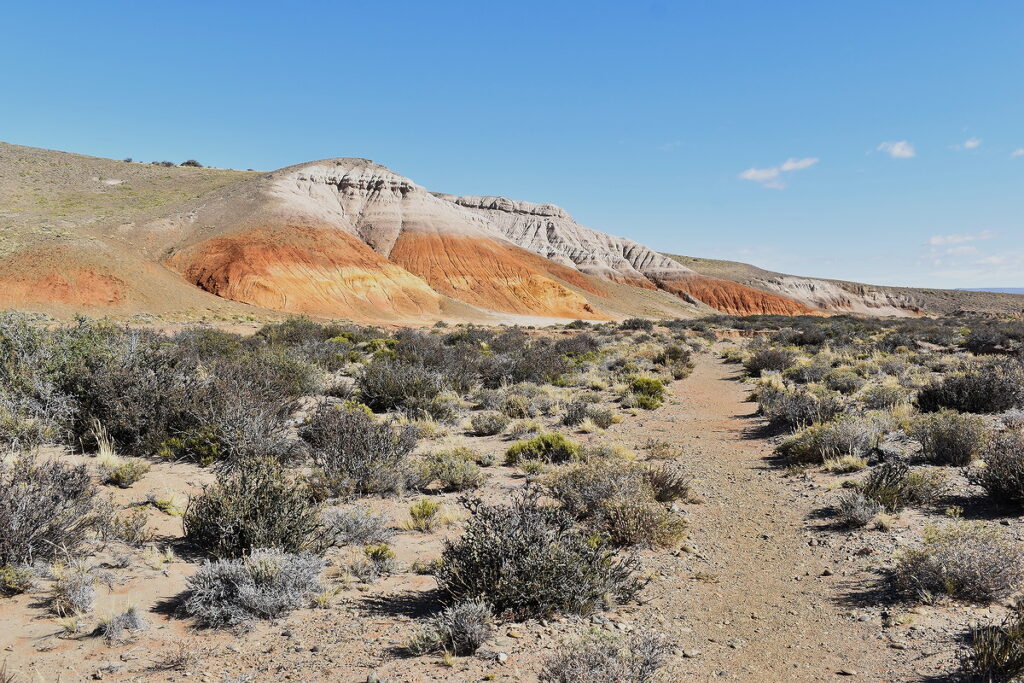
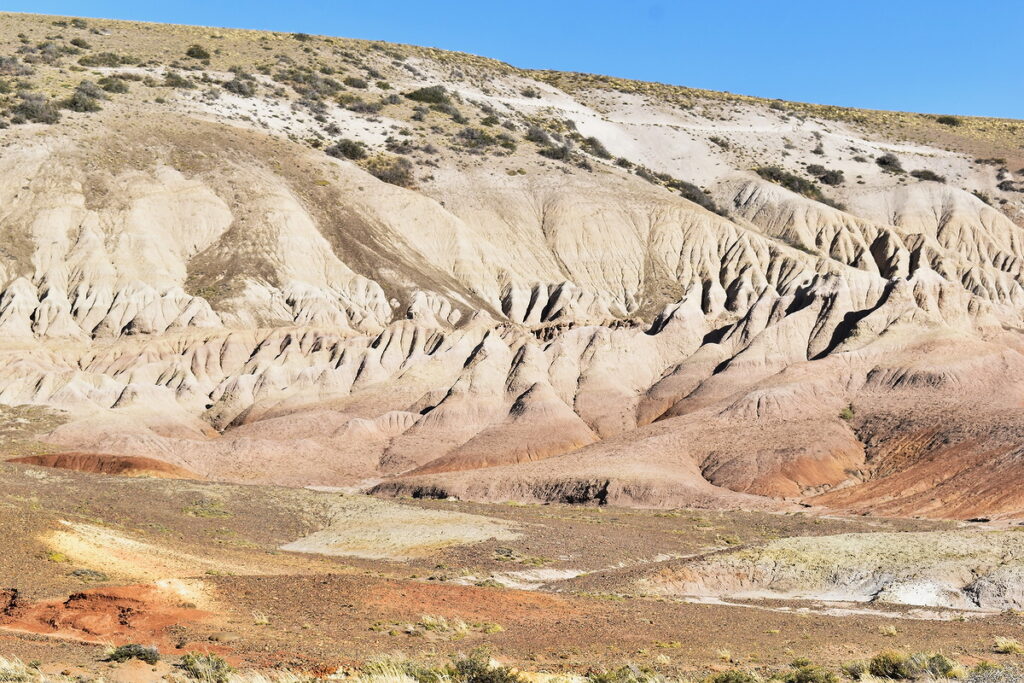
The beginning of the trail is flat, with orange and beige rock formations to the left, but otherwise located in the open plains. This means there is no shelter from the wind, so be prepared!
About halfway through the hike, there is a short ascent to the main viewpoint. Suddenly you’ll be met with the most beautiful shades of pink, and yellow, and orange – truly unlike anything I’ve seen before!
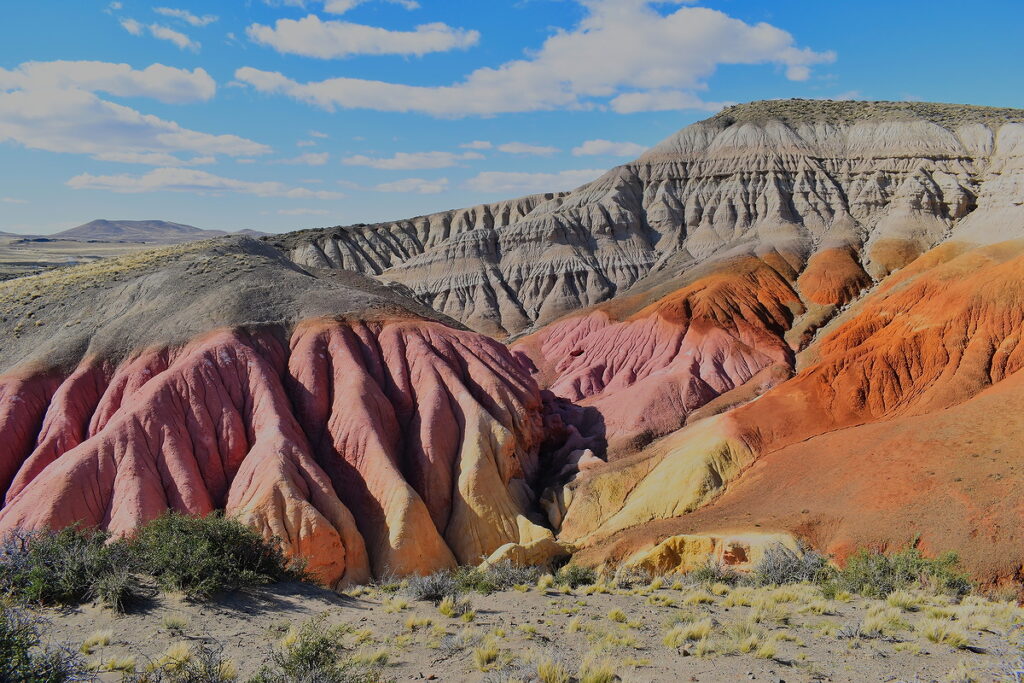
After you’ve snapped as many pictures as you possibly can, you can return the way you came or continue the loop back to the parking lot.
Bajada de los Toldos and Cueva de las Manos Trails
These two trails are complementary. Bajada de los Toldos takes you down the canyon and across the river, while Cueva de las Manos trail takes you back up the other side of the canyon to the Cueva de las Manos visitor center.
Bajada de los Toldos Trail
Distance: 1.7 km (1.1 miles)
Difficulty: Rated high officially, but I’d say it’s easy to medium
Cueva de las Manos Trail
Distance: 1 km (0.6 miles)
Difficulty: Rated high officially, but I’d say it’s easy to medium
Combining these two trails takes you to the Cueva de las Manos cave paintings site, which is technically in a separate park. To visit the Cueva de las Manos Provincial Park you’ll need to join a tour when you arrive and pay a $36,000 peso entry fee (price for foreigners).
Read more: How to Visit Cueva de las Manos, South America’s Oldest Cave Paintings

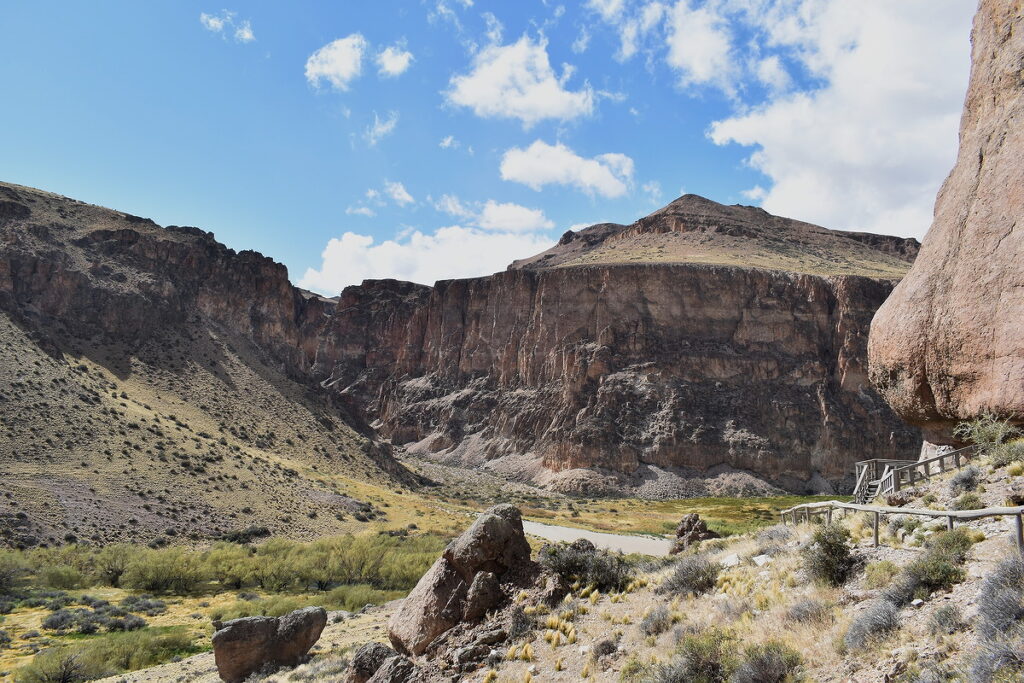
The hike itself involves an 80 meter descent down the canyon. The trial is a combination of low grade switchbacks and steps, so it is not challenging. As you descend you’ll get amazing views of the canyons and the valley through which the Rio Pinturas flows.
Once you reach the bottom you’ll cross the river, and begin ascending the other canyon taking the Cueva de las Manos trail. The trail ends at the visitor’s center parking lot, where you can sign up for a Cueva de las Manos tour. The entire hike took us about 45 minutes one way.
The Cueva de las Manos is not to be missed!

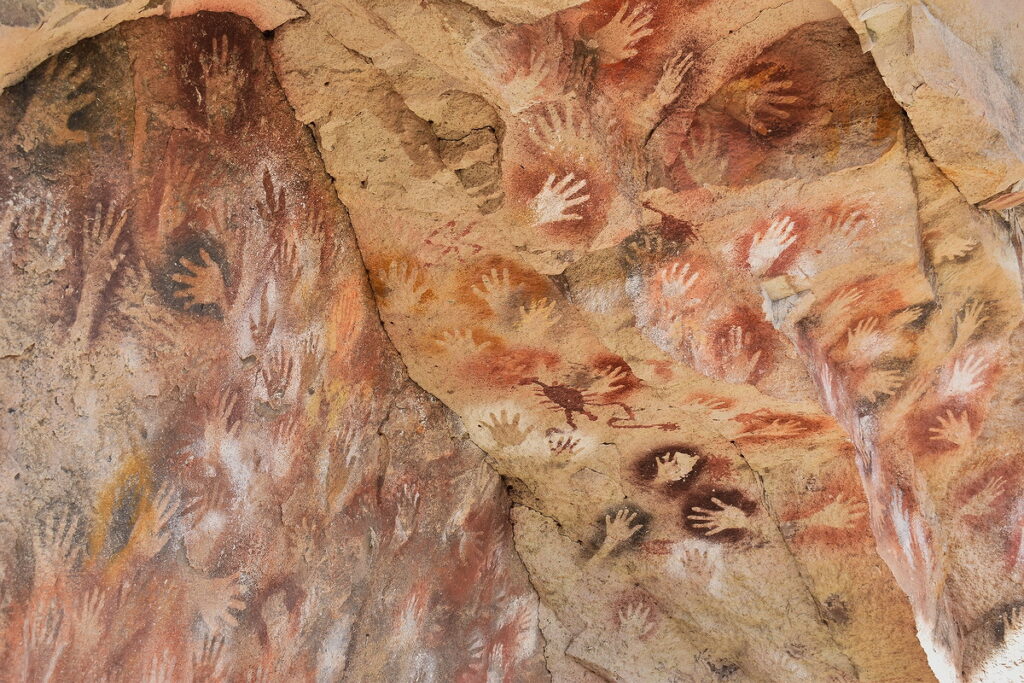
Alero Charcamata
This is a full-day excursion that can only be done with a guide. Visitors can make reservations at La Posta de los Toldos (the hotel located within the park), or in Perito Moreno.
The tour begins with a 30-minute drive to the Charcamara canyon, where you’ll embark on an hour-long hike to the alero (a rock formation). You’ll cross the river to arrive at a large cave (80 m wide, 40 m high) with cave paintings that date back 5000 years. These paintings are similar to those in Cueva de las Manos, but fewer in quantity and variety.
While we didn’t do this tour, I would have loved to with more time. This video is a great summary of what the outing is like, and it looks awesome!
Staying in Portal Cañadón Pinturas
If you choose not to stay in Los Antiguos or Perito Moreno, there are a couple of lodging options in the portal: La Posta de los Toldos, which is a hotel, and camping.
La Posta de los Toldos
La Posta de los Toldos is a hotel not far from the park’s entrance. This is a great option for visitors looking to spend unhurried time in Portal Cañadón Pinturas. There is a restaurant on site, so won’t have to make the hour + drive to one of the cities.
Camping
Camping in Portal Cañadón Pinturas is free and open to the public. You can choose to reserve a spot up to 15 days in advance, but this isn’t necessary. There are three campsites in the park:
- Camping la Confluencia
- Camping del Rio
- Camping la Señalada
Camping la Confluencia and Camping del Rio are fairly primitive. They have platforms for tents and compost toilets, but no electricity or running water. You can save your spot at either of these campsites by emailing [email protected].
Camping la Confluencia is located between two canyons by the river, and has six platforms for tents. Camping del Rio is located by Rio Pinturas, at the southernmost area of the park. It’s shielded from winds by a group of alamo trees, and has four platforms for tents.
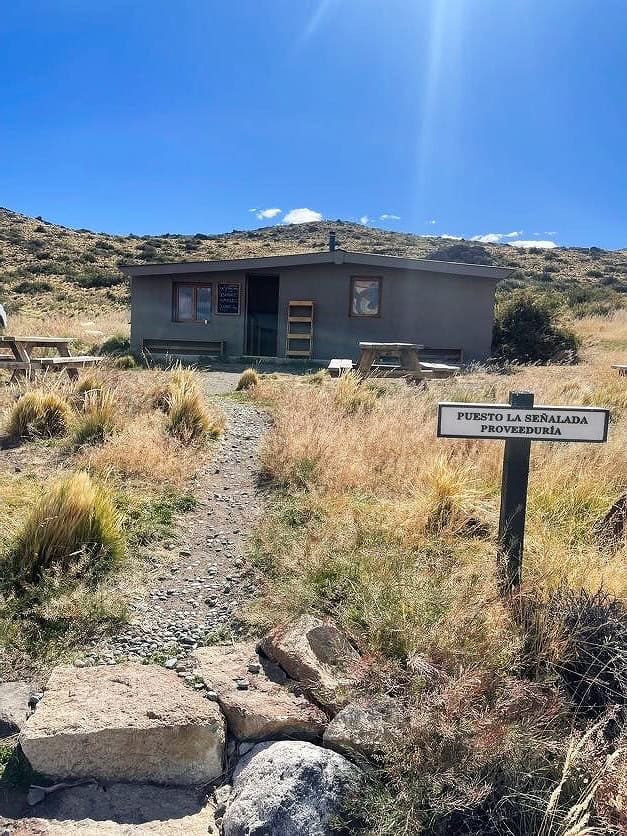
Camping La Señalada is located right by Puesto La Señalada Proveduria, a small grocery that also makes home cooked meals to sell to park visitors. We had some osso bucco empanadas here that were absolutely incredible.
This campsite has twelve parapets that provide shelter from the wind. There is also a communal fire pit, picnic tables, and running water. The parking lot is next to the campsite, so you won’t need to hike in. You can save your spot by emailing [email protected].
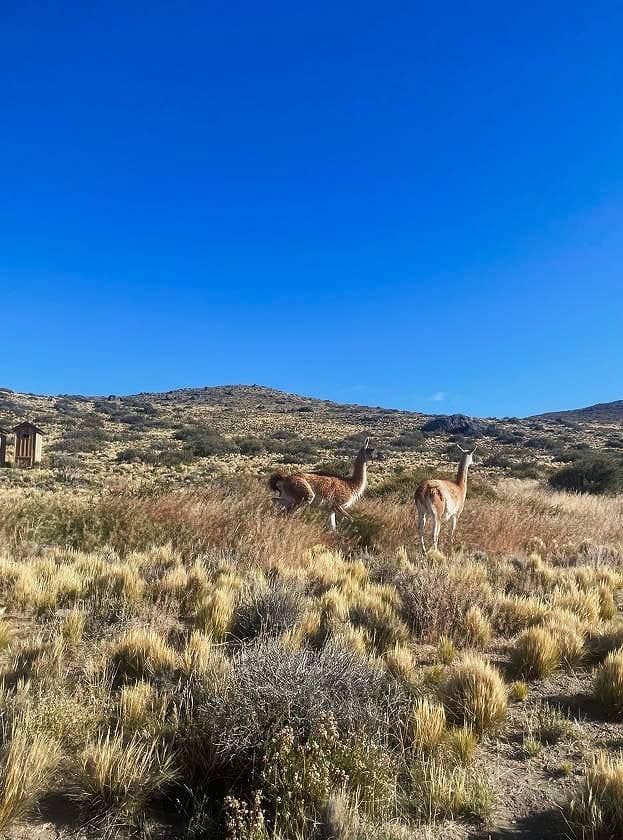
Final Thoughts
While Portal Cañadón Pinturas is an out-of-the-way destination, I really think it’s worth the detour. A trip to Patagonia isn’t complete without a dose of archaeology, wildlife, and dramatic steppe canyons. Even better, you can experience all this on a few day hikes!
Let me know if you have any questions about this destination!
Read More About Patagonia Travel
How to Visit Cueva de las Manos, South America’s Oldest Cave Paintings
Explore Patagonia: El Calafate and El Chaltén Itinerary
How to Visit the Perito Moreno Glacier
El Chalten Hiking Guide: 5 Best Day Hikes
Navigating Money in Argentina: A Traveler’s Guide to Exchange Rates, Cash, and Credit Cards
Victoria is an Austin-based travel content creator passionate about encouraging her readers to step outside of their comfort zone and step in to a life of adventure. She is the founder of the travel blog Nomad No Problem.
